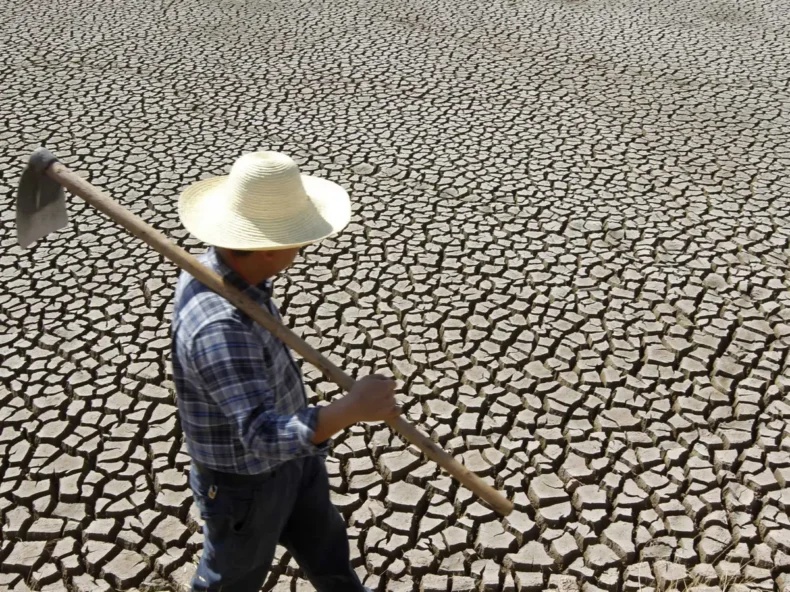Late Thursday China issued its first national drought alert in nine years. Yangtze delta regions from the southwest of Sichuan to Shanghai are currently experiencing extreme heat conditions.
Chinese authorities say the root cause of the drought is global climate change. On the Beijing scale, the yellow alert is just two notches short of the worst nationwide alert.
News agency Xinhua reports that one of the Yangtze river’s vital flood basins, the Poyang lake in the Jiangxi region of central China, has reduced to a quarter of its previous size.
According to the CCTV state broadcasters, at least 34 counties in Chongqing, the southwestern region have witnessed the drying up of a staggering 66 rivers.

Citing local government data, CCTV also reported that the Chongqing region rainfall has fallen by 60% of its normal seasonal rate, as a result, the soil in the region has started to become arid and lost moisture.
Aside from rainfall, the Chongqing region is boiling up and is accounting for six out of ten of the hottest places in China by today’s morning. Shanghai currently is at 37 degrees Celsius while the district of Bishan is experiencing 39 degrees.
As a result of the extreme temperatures, cases of forest fires and mountain blazes are erupting in several places in Chongqing. People in the region are also experiencing heat strokes in large swathes.
Districts such as the Fuling are getting notices from the gas utilities that supplies will be cut off until the “serious security hazards” are taken care of.
It is expected that the official agricultural bureau in the region is setting up expert teams on crop harvesting projects. They aim to protect crops at risk as well as expand the growth of the lost cultivation for compensation.
The decreasing levels of water in the region have also raised alarm by the water ministry. There will be determined quotas for a limited time to draw up rotas. It will ensure that the water in the region does not run out immediately.
Some regions north of Chongqing such as the district of Beibei are experiencing extreme heat as temperatures are hitting the 45-degree Celsius mark, the Weather bureau of China has reported.
Loss to the Chinese Economy
Last month was rough on the Chinese losses, as the extreme temperatures caused a severe loss of at least 3 billion yuan (~$400 million) directly to the Chinese GDP. This will cause havoc for 5.5 million Chinese people. This research was conducted by China’s emergency ministry.
The peril of high temperatures has not stopped for a month now as the red alert on Friday was the consecutive 30th alert issued in China. The ongoing heatwave will slow down around 26 August only.
The Chinese weather agencies have reported that a staggering 4.5 million square kilometers of China have experienced temperatures of over 35 degrees Celsius.
China’s struggles with climate change

In 2022, China is home to 140.21 crore people.
It is unimaginable how China will handle the oncoming problems caused by climate change that will impact almost every single one of the 140 crore people.
The ongoing problem wreaking havoc in China is a direct result of global warming and mismanagement of natural resources in the current region.
Chinese authorities and expert teams are also currently battling the Yangtze river basin drought situation. Efforts are being made to protect vulnerable crops as well as maintain the water levels of the affected regions. It is certainly not an easy task.
But predictions by the IPCC and several environmentalists consider that the situation in China is going to get much worse than it is now.
China is also the world’s largest emitter of Carbon dioxide as the industry in China was and continues to be built upon the energy provided by fossil fuels and coal.
Current situations in China will result in battles in sectors of agriculture, water management, forestry, etc.
The Chinese climate policy is complex, the exact notion of it is to “under promise to deliver more than expected.”
The measures taken will have low targets but in the long run, can complete or even over achieve their targets.
The targets set by the Chinese authorities are to be carbon neutral by 2060, depend on renewable energy more and they have also made vows to hit peak emissions in 2030.
Read More – Taiwan Displays Cutting-Edge Fighter Jets Made In The US Amid Tensions With China.













